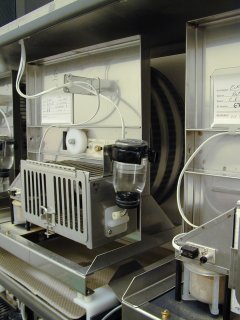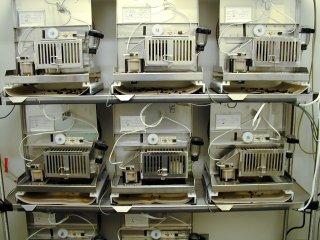|
Activity-Based
Anorexia |
|
Anorexia
Nervosa Anorexia nervosa is a complex eating disorder
characterized in part by hypophagia, disorganized eating patterns, body
weight loss, hyperactivity, and a dysregulation of the
hypothalamic-pituitary-gonadal axis resulting in low serum levels of
estradiol and amenorrhea in women and low serum testosterone levels in men.
Another prominent feature of anorexia nervosa is the sex difference in
susceptibility. Current statistics indicate that more than 90% of the cases
of anorexia nervosa occur in women. Therapeutic treatment of the symptoms of
anorexia nervosa is limited due to our lack of understanding of the multiple
factors underlying this complex eating disorder. The use of animal-based
research, therefore, has the potential to increase our understanding of the
behavioral, physiological, and neural changes associated with anorexia
nervosa. |
|
Activity-Based
Anorexia Model Activity-based anorexia is experimentally
induced in rats by restricting food intake to one brief daily feeding period
(1.5-3 h) and providing access to running wheels during the remainder of the
day (21-22.5 h). In addition to a reduction in food intake, rats display an
increase in running wheel activity, a progressive loss of body weight, and a
disruption of the estrous cycle in females. Activity-based anorexia in rats is dependent
upon the interaction between food restriction and running wheel activity.
Chronic food restriction, in the absence of running wheels, induces only a
transient decrease in food intake and body weight. Within 2-3 days,
food-restricted rats maintain their body weight and then begin to gain body
weight despite limited access to food. Additionally, female rats maintained
on a chronic food restriction schedule show minimal or no disruption of the
ovarian cycle. These studies illustrate that the hyperactivity expressed by
food restricted rats is a fundamental component of the activity-based
anorexia model. |
Custom-designed
cage to monitor food intake, spontaneous feeding patterns and running wheel
activity. |
|
Colony Room
for Activity-Based Anorexia Studies Spontaneous food intake is monitored by a
combination of photo beams and load beams. Feeding niches are equipped with
infrared light emitting diodes and phototransducers that signal the
occurrence of feeding bouts. Sensitive load beams (+/- 0.001 g), located
below the food cups, are used to monitor the amount of powdered rat chow
consumed during feeding bouts. A dipole magnet is used to monitor every
revolution of the running wheels. Custom designed software (created by Ross
Henderson here at FSU) is used to reconstruct the rat's feeding and running
wheel patterns.
|

